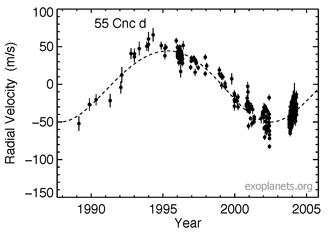Lipperhey (exoplanet)
|
Exoplanet Lipperhey |
|
|---|---|
| Artist's impression | |
| Constellation | cancer |
| Position equinox : J2000.0 |
|
| Right ascension | 08h 52m 35.81093s |
| declination | + 28 ° 19 ′ 50.9511 ″ |
| Orbit data | |
| Central star | Copernicus A |
| Major semi-axis | 5.446 ± 0.02 AU |
| eccentricity | 0.0269 +0.0061−0.0065 |
| Period of circulation | 4867 +25−26 |
| Further data | |
| Dimensions | 3.86 +0.6−0.15 M J |
| distance | 12.5 pc |
| method | Radial velocity method |
| history | |
| discovery | Geoffrey Marcy et al. |
| Date of discovery | 2002 |
| Catalog names | |
| 55 Cancri d, HD 75732 d | |
Lipperhey ( 55 Cancri d ) is an exoplanet orbiting the component Copernicus A of the binary star system Copernicus . Due to its high mass , it is assumed that it is a gas planet . He is the fifth and outermost of the previously known planets in his system .
discovery
This exoplanet was discovered using the radial velocity method . Lipperhey was discovered together with the planet Brahe by Geoffrey Marcy and R. Paul Butler as the second and third planet of the system in 2002. At this point, Copernicus had been observed for 12 years.
Track properties
The planet orbits its star at a distance of about 5.5 AU . Since initially a system with three and later four massive planets was assumed, the results were highly eccentric orbits for Lipperhey. In the model with five planets, as it is currently assumed, the eccentricity is rather small at 0.025 and its orbit is almost circular. The period of rotation is given as almost 5000 earth days (more than 14 years). Its orbit is similar to that of Jupiter .
Physical Properties
Lipperhey has a mass of at least 1219 M ⊕ or 3.835 M J . Measurements with the Hubble Space Telescope suggest an inclination of the plane of the orbit of 53 °, according to which the mass would increase to 4.8 Jupiter's masses. The radius of Lipperhey is likely a little less than that of Jupiter.
There are no reliable data on the composition, size and temperature; corresponding speculations are based on model calculations. Lipperhey is very likely to be a gas planet, which is likely to consist mainly of volatile elements such as hydrogen and helium. Due to the large mass, the heat arising from internal processes such as gas contraction could make the planet so warm that it is covered with white clouds of water.
Origin of name
Like all exoplanets, Lipperhey was originally designated with the star's official name and a lowercase letter, according to the order in which it was discovered. After a publicly advertised competition by the International Astronomical Union (IAU), it was officially named on December 15, 2015 after the Dutch eyewear maker Hans Lipperhey , the inventor of the telescope .
Web links
swell
- Debra A. Fischer et al .: Five Planets Orbiting 55 Cancri. (2008) The Astrophysical Journal , 675: 790-801. doi: 10.1086 / 525512 , arxiv : 0712.3917
- Geoffrey Marcy et al .: A Planet at 5 AU around 55 Cancri. (2002) The Astrophysical Journal, 581: 1375-1388. doi: 10.1086 / 344298
Individual evidence
- ↑ Simbad
- ↑ a b c d e f Exoplanet.eu
- ↑ David Sudarsky, Adam Burrows, Ivan Hubeny: Theoretical Spectra and Atmospheres of Extrasolar Planets Giant. (2003) The Astrophysical Journal, 588: 1121-1148. doi: 10.1086 / 374331
- ↑ International Astronomical Union: NameExoWorlds - The Approved Names. Retrieved January 3, 2016 .


